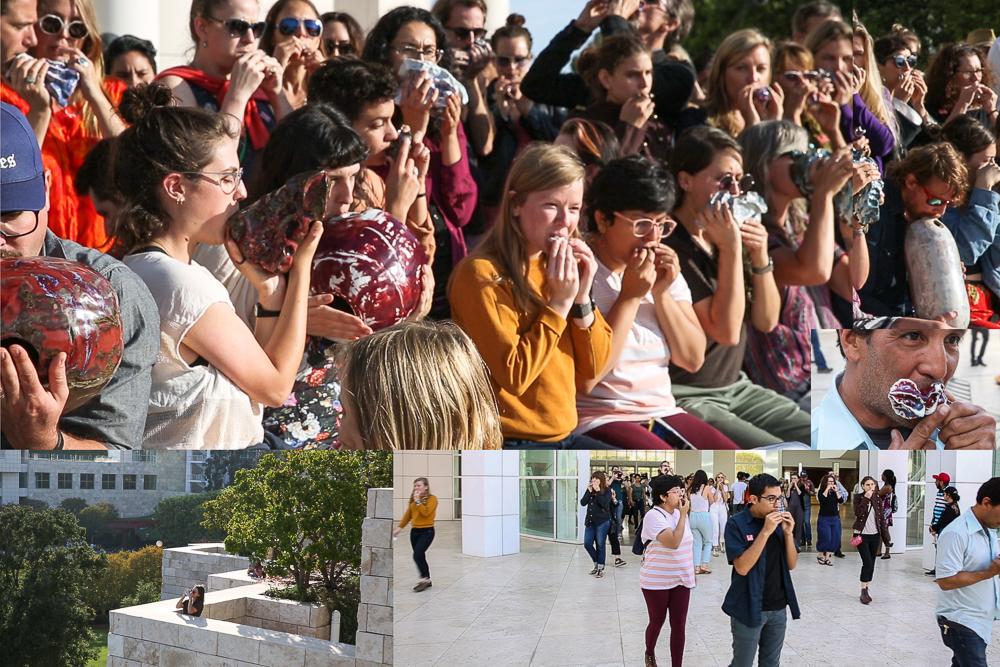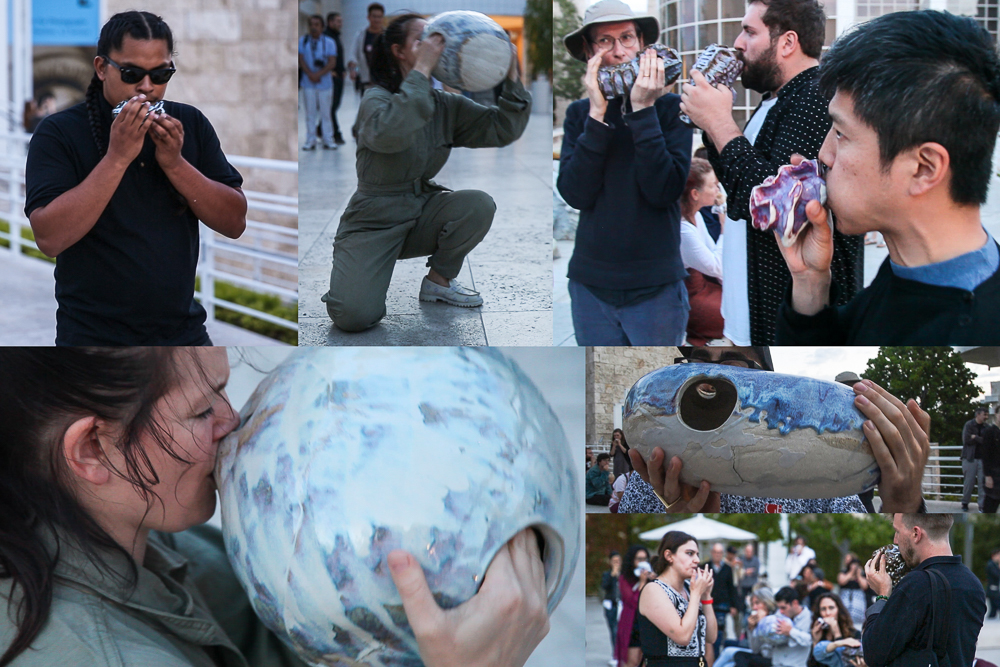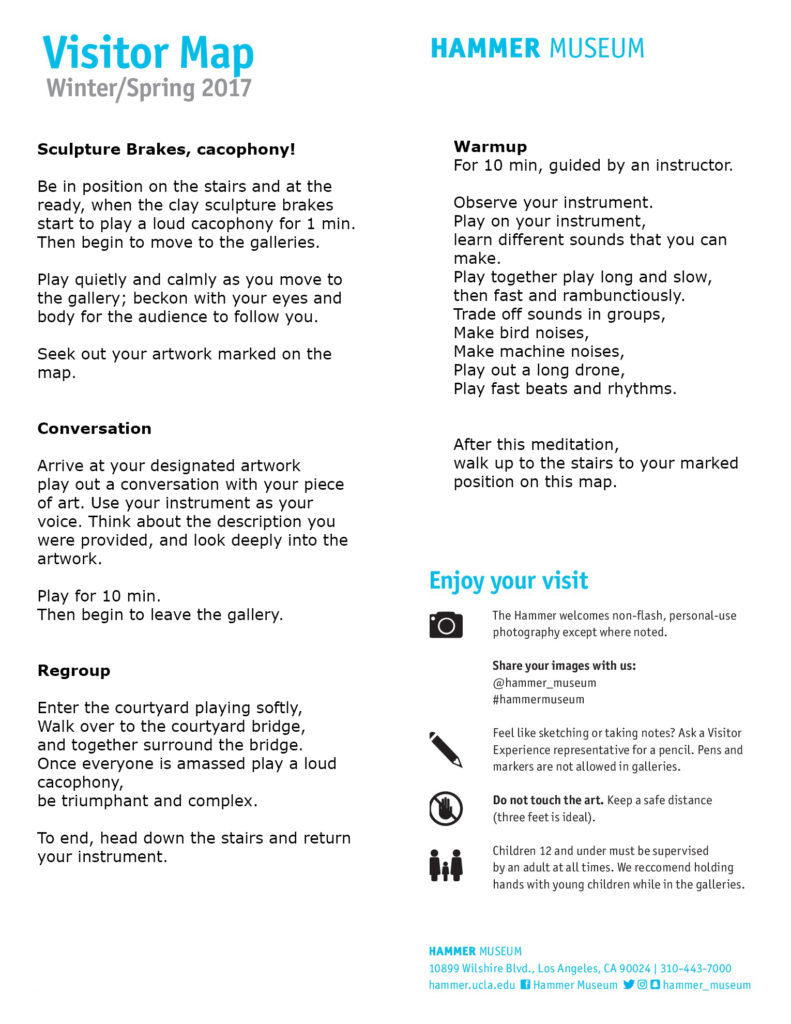JUICERINAS
Juicerinas are a set of sculptural musical instruments built in collaboration between artists Wesley Hicks and Michael Parker. With 100+ instruments, the Juicerinas are used to create dynamic fluid performances that can all at once be cacophonous, playful, and triumphant. These ceramic instruments built in collaboration between the artists come in sizes from smaller then a lime to larger than a watermelon. These instruments produce a fluid and amorphous sound much like the chirps of birds and the calls of whales. The intuitive-to-play instruments are used by volunteer performers. The performers harness these sounds as a collective voice, one that can be spread over vast spaces, filling them with sound. The performers act as radical cartographers, navigating and claiming the performance space as their own temporary autonomous zone. Notable performance venues include the Getty Center, Hammer Museum, Palm Springs Art Museum, Pomona College Art Museum, and Southern Exposure.

These ceramics instruments and are glazed vibrantly in red, blue, and purple. Each is a unique shape and size, modeled independently of one another. The shapes are based off of Micheal’s citrus juicers and melon sculptures from his project “Juicework” at Human Resources. The project that led to the instruments’ development. We gave them the name Juicerina, as it was a hybrid of the form of a juicer and function as an ocarina – which Wesley has been making since he was 14. Juicerinas are capable of playing graceful pitch bends that are bird like or whale like depending on the size of the instrument. They do not easily play familiar melodies as the instrument changes pitch fluidly with gentle motions of the hand, instead of the specific and rigid pitches found on most flutes. The construction of the instruments makes them both democratic and intuitive to learn and to play, with most players capable of museum quality performance on the instrument within ten minutes.

At the Getty Center we set up several events involving the use of these instruments. To start, performers gathered at the front of the museum, performing a cacophony and then slowly separating from one another, walking through the interstitial and liminal spaces of the museum’s exterior. The second major performance started with one or two performers in each of the 60+ galleries of the museum. The score calls for gestural conversations with specific works of art – those carrying references to sound and labor with performers improvising what they felt were appropriate sounds given their instruments’ range. The performance finished with a re-gathering at the central fountain and performing a final chaotic cacophony of sound.
Working together with Michael we made over 80 Juicerinas for the Getty Center performance. They are democratically played by anyone, even those unfamiliar with playing an instrument. These pitch fluid instruments were given simple, text based scores guiding the performers. Various interactions included joining in with the birds in 17th century french tapestries, calling out from liminal spaces between museum stairways, and forming a cacophony of sound as the +80 performers joined together on the front steps of the museum.
OTHER PERFORMANCES
The first Juicerina performance at Human Resources
Here is the demo video used for the Pomona College Performance explaining how a Juicerina works.
SCORES

Throughout the performances with the Juicerinas various unique scores have been used. Each venue receives a unique score that is designed around the physical characteristics of the space and the general tone that we want the work to focus on. This is greatly effected by the institutions and the kind of space the performances are in. Over time the scores have zoned in on specific language and have been dramatically simplified. A mixture of simple language and poetic gesture work well for giving commands and describing creative intent.
Playing with art at the Getty
A score for Juicerina ensemble by Wesley Hicks and Michael Parker
This score is required to be performed at the galleries of the Getty Center.
This is a score for between 50-100 performers.
This score will require a map of the museum for each performer.
A list of observations of the collection at the Getty Center are to be constructed, with artwork from each room being observed and selected for players to interact with in this score. The observations are of artwork that is currently on display at the museum during the time that the performance takes place. These observations will be constructed into a map that will be given to each performer. All performers will use these observations and map to construct a set of interactions with a work of art in each room at the museum for fifteen minutes at the same time.
Step one: Instructions for Michael and Wesley
Observe the galleries at the Getty
Select works of art that are related and interested in the themes of trade, commerce, birds, fruit, shells, singing, music, dance and celebration. Think of things that make sound, and are related to themes of the project as a whole. For example ships with horns, and ships as a device of transport for goods and food. Observe works at the museum and create a map of the observations, noting down a feature for each room that is of interest. This can be written down as a simple statement for each room. These features will be used later as a prompt for interactions the performers will have with works on display. Construct maps for each performer using the maps available from the museum, each performer will receive a unique map hat only displayed the room they will interact with. These maps will be paired with an instrument that is appropriate for the interaction that will take place. These maps will be handed out along with an instrument to each performer.
Hand out the maps
The maps that have been made will then be handed out to performers along with an instrument. At this point performers will become versed with how to play the instrument and receive some minor instructions on techniques they can use. Performers will not be versed on what to do in their assigned gallery space. From this point onward it is up to the interpretation of the performer to decide on the resulting sounds that will be made.
Align everyone up on time
Timing on this performance is of special importance. You will work with the performers to get them aligned on time and aware of the moment the performance will begin and when it will end. This can be aligned using cell phones and silent, or buzzing alarms that will all be synchronized to go off at the beginning of the performance and at the end.
Step two: Instructions for performers
Preparations
Using your map, locate your room and read the comment about the artwork you will interact with. Think over this interaction, what might the name lead you to think of in terms of a musical conversation you can have on your instrument. Become acquainted with your instrument, observing various ways you can play on it and various finesses and unique sound you can make.
Working with Wesley and Michael, find a way to align everyone time up so that each performer will begin and end the performance at the same time.
Walk to your assigned room
When you enter the room you have on your map, locate the work of art that the short statement is describing. If the description is ambiguous select the work of art that best fits the description for you. Begin playing at the time that has been selected interact with the artwork, playing sounds based on your initial interpretation as well as observations you have made yourself with the work.
Liminal Spaces
This score is required to be performed at the galleries of the Getty Center
This is a score for between 40-60 performers
This score will require a map of the museum for each performer.
This score is to follow a performance of Playing With Art at the Getty
Following each performer finishing up with Playing With Art at the Getty the performers will move to another location marked each persons map. This location is that of a hallway or rest area at the museum, some outdoors and some indoors. These liminal spaces of the museum, ones which an individual is between two locations are the ones from which the performers are to interact with.
Each performer will find their position in this space and play long tones, ones which the performer does little to no motion with the instrument while they exhale breath into the instrument, then taking a brake to take in another breath and continuing to play continuously. This will continue for about 10 minutes. This is effect is taking into consideration these spaces that are noticed by a museum goes, they are without distinction and the aspect that a performer is playing in them leads to them being noticed.
Crickets
A 10 minute performance for between 8-15 players in interaction with Chris Kallmyer.
This work is thinking more rhythmically then melodically. Thinking of patterns of communication, syncopation and the creation of independent, isolated moments as well as moments of communication between players. In this work players will play rapid rhythmic sets of sounds, much like the sound of a cricket. This fast percussive and rhythmic sound will be overlapping other players, to make complex harmonic interactions. Overblown sounds and shrill sounds are also welcome, given what is possible on each player’s instrument.